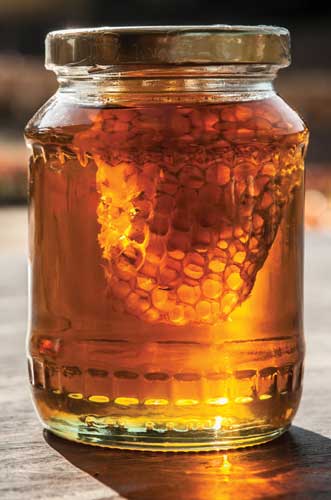Food Forensics: Investigating Food Crime
FOOD SAFETY AND QUALITY
 Forensic science is increasingly being used to investigate and solve crimes. The science involved in criminal forensics is also being applied to the investigation of food quality problems and food safety issues. Companies undertake food forensic investigations for many reasons, such as to identify problems that may have affected the quality and safety of their products, to respond to consumer complaints or problems found in routine quality control testing, and to protect the company’s reputation and liability. The problems may involve the presence of foreign materials and contaminants in raw materials and finished products; off-odors, off-flavors, and appearance problems; microbial spoilage; foodborne illness; and intentional adulteration to cause harm or to defraud for financial gain.
Forensic science is increasingly being used to investigate and solve crimes. The science involved in criminal forensics is also being applied to the investigation of food quality problems and food safety issues. Companies undertake food forensic investigations for many reasons, such as to identify problems that may have affected the quality and safety of their products, to respond to consumer complaints or problems found in routine quality control testing, and to protect the company’s reputation and liability. The problems may involve the presence of foreign materials and contaminants in raw materials and finished products; off-odors, off-flavors, and appearance problems; microbial spoilage; foodborne illness; and intentional adulteration to cause harm or to defraud for financial gain.
The U.S. Food and Drug Administration (FDA) has issued a final rule requiring food companies to develop mitigation strategies to protect food against intentional adulteration, as required by the Food Safety Modernization Act. The rule is aimed at preventing intentional adulteration intended to cause widespread harm to public health, including acts of terrorism targeting the food supply. It does not cover economically motivated adulteration (EMA), but EMA is addressed in the FDA’s final rules on preventive controls for human and animal foods.
Symposium Addresses Food Forensics
In the symposium “Food Forensics: Scientific Investigation of Urgent Food Safety and Quality Issues” at the Institute of Food Technologists’ annual event in 2017, speakers discussed how the FDA, food companies, and universities are addressing food forensics. Jinping Dong, principal scientist and leader, global initiative on forensics solutions, Cargill, said that the food industry is being challenged daily on various food safety and quality issues and that it is a good time to bring together experts to address the matter. He said that Cargill’s initiative and efforts for a global harmonized approach on food forensics provides scientific investigation support on urgent issues related to food, ingredients, materials, and processing. Common examples include presence of foreign materials (chemicals, microorganisms, and objects); contamination from food manufacturing and by consumers; presence of allergens; problems such as off-color, off-flavor, and off-odor; change in viscosity, texture, and other physical properties; and so on. Forensics focuses on why the problems are occurring and how to prevent them from happening again, he said.
Michael Mortenson, principal scientist and physical chemistry group lead, Cargill, described Cargill’s strategy for investigating off-flavor problems. The steps are initial consultation, sampling, smell/taste consultation, and development of the analytical approach to be taken. The analytical approach starts with simple headspace extraction, followed by more rigorous extraction and devising of a new approach if needed. He illustrated his remarks with examples of isolation, detection, and identification of 2,4-dichlorophenol, 2-bromoanisole, and various fermentation or lipid oxidation–derived compounds from a variety of commodity ingredients. He concluded by saying that all investigations of off-flavors and taints are a blend of art and science, require frequent communication, and rely on sensory perception.
Steven Zbylut, global research and development manager, General Mills, covered the technologies used at General Mills to investigate foreign material issues arising from manufacturing problems, consumer complaints, economic adulteration, packaging material problems, ingredient problems, and off-flavors. They include microscopic techniques, physical techniques, and spectroscopy techniques. He illustrated his discussion with examples: An investigation of a consumer complaint about a foreign material in a product found that it was actually an ingredient, a crystalline salt. In another example, the company investigated a skim milk powder for evidence of EMA by analyzing it for the presence of small organic compounds, small inorganic compounds, and biological macromolecules. Each compound has a unique spectral fingerprint, he said, and the results showed the feasibility of using spectral methods for adulterant detection, adding that chemometric modeling is sometimes needed to magnify differences. Other examples included identification of generally recognized as safe (GRAS) layers in packaging film, off-flavor in soups, and comparison of natural vs synthetic beta-carotene. Zbylut concluded by saying that these technologies allow for physical, visual, and chemical identification of foreign materials and authentication of incoming ingredients to ensure that safety and quality issues can be resolved before products reach consumers.
 Jennifer Brzezinski, team leader, microbiology and molecular biology, FDA Forensic Chemistry Center (FCC), said that the FCC does forensic case work for the FDA’s Office of Criminal Investigations; conducts research and methods development; assists in national and international health emergencies; provides assistance to other regulatory and law enforcement agencies; and helps regulatory laboratories investigate chemical contamination of food and drug products, tampering, terrorism, and EMA. For example, in an investigation of baby food that was said to have been poisoned, a multifactorial approach utilizing gas chromatography and mass spectrometry, lateral-flow and ELISA immuno-assays, liquid chromatography and mass spectrometry, optical microscopy, Western Blot, and capillary liquid chromatography and time-of-flight mass spectrometry confirmed that the adulterant was ricin from ground-up castor bean. In other examples, total ion chromatography and full-scan mass spectroscopy analysis of pellets removed from poisoned chili showed that they contained the active ingredient in rat poison, brodifacoum; isotope-ratio mass spectrometry was used to detect economic adulteration of honey with less-expensive syrups; seafood samples that had already passed sensory analysis after the Deepwater Horizon explosion in the Gulf of Mexico were analyzed for the presence of polyaromatic hydrocarbons to determine whether the seafood had been contaminated; speciation of organic and inorganic arsenic in juices and rice products was done by chromatographic separation followed by inductively coupled plasma mass spectrometry detection; and DNA bar coding was used to identify fish species in an effort to reduce EMA by substitution of less-valuable species for others.
Jennifer Brzezinski, team leader, microbiology and molecular biology, FDA Forensic Chemistry Center (FCC), said that the FCC does forensic case work for the FDA’s Office of Criminal Investigations; conducts research and methods development; assists in national and international health emergencies; provides assistance to other regulatory and law enforcement agencies; and helps regulatory laboratories investigate chemical contamination of food and drug products, tampering, terrorism, and EMA. For example, in an investigation of baby food that was said to have been poisoned, a multifactorial approach utilizing gas chromatography and mass spectrometry, lateral-flow and ELISA immuno-assays, liquid chromatography and mass spectrometry, optical microscopy, Western Blot, and capillary liquid chromatography and time-of-flight mass spectrometry confirmed that the adulterant was ricin from ground-up castor bean. In other examples, total ion chromatography and full-scan mass spectroscopy analysis of pellets removed from poisoned chili showed that they contained the active ingredient in rat poison, brodifacoum; isotope-ratio mass spectrometry was used to detect economic adulteration of honey with less-expensive syrups; seafood samples that had already passed sensory analysis after the Deepwater Horizon explosion in the Gulf of Mexico were analyzed for the presence of polyaromatic hydrocarbons to determine whether the seafood had been contaminated; speciation of organic and inorganic arsenic in juices and rice products was done by chromatographic separation followed by inductively coupled plasma mass spectrometry detection; and DNA bar coding was used to identify fish species in an effort to reduce EMA by substitution of less-valuable species for others.
Brzezinski said that forensic challenges include food variety, food complexity, food components (fats, proteins, carbohydrates, etc.), rarely existing methodology, and international relationships. For most samples the FCC receives, she said, there is no method and a lot of methodology has to be generated quickly. She added that the center also cooperates with the other FDA laboratories in building databases of foodborne pathogens such as Listeria monocytogenes and Salmonella.
John Spink, director of the Food Fraud Initiative (FFI) at Michigan State University, said that forensic science related to crime has been around for a long time and food scientists can use that expertise for food forensics. In a lot of the suspicious activity reporting, he said, there’s no definition of the sampling method used, the process used, whether it was validated, and whether the result was verified. It’s important to know the source of the information, the date of the incident, whether the ingredients used in the finished product are authentic, and whether other ingredients interfere with the analysis of the critical ingredients.
Developments and Challenges
In subsequent interviews with the symposia speakers, Dong said that Cargill defines food forensics as urgent scientific investigations of Cargill products regarding potential safety and/or quality concerns, which may impact health, cause harm, or result in a loss of sales or reputation for Cargill or its customers. What’s common between food forensics and criminal forensics, he said, is the investigation process. Both involve scientific procedures to find the cause of the incidence, but food forensics focuses on food and ingredients, most of the time on safety issues. Issues related to food quality and processing are also investigated under the forensics realm because they may pose potential safety concerns by consumers. The goal is to ensure safe and high-quality products.
Cargill’s major developments related to food forensics in the last few years have been to streamline the case-handling processes, apply new technologies to achieve faster and more accurate analysis, and find gaps where forensics can help to improve products. The main challenge, he said, is that each case or incident is different, meaning that new or different methods and tools are constantly needed to solve the cases. There are standard methods and databases for common food safety cases but not for day-to-day industrial issues. There needs to be a system to track all existing cases so that people can easily search and learn what has been done.
Cargill does most of its forensics work internally, he said, but uses external laboratories when there’s an overflow of requests or when other Cargill locations don’t have internal analytical capabilities. Dong said that Cargill has evaluated forensics offerings from commercial laboratories and has better capability and experience than most of them.
 Mortenson said that in addition to emphasizing Cargill’s priority on food safety and quality, his working definition of food forensics includes scientific activities to address criminal activities related to food such as mislabeling, adulteration, etc., but also expands to protection of sales and/or reputation of ingredient or organization. From the perspective of off-aromas and taints, he feels that developments in food forensics are linked strongly to developments in the analytics utilized. The industry will always encounter taste issues, he said, so staying current with new technology or finding innovative ways to utilize existing analytical techniques is important to become more efficient in solving problems. He said that there will likely be an increased number of unexpected final-product quality issues as a result of formulation adjustments in response to changes in regulatory requirements and shifting consumer desires.
Mortenson said that in addition to emphasizing Cargill’s priority on food safety and quality, his working definition of food forensics includes scientific activities to address criminal activities related to food such as mislabeling, adulteration, etc., but also expands to protection of sales and/or reputation of ingredient or organization. From the perspective of off-aromas and taints, he feels that developments in food forensics are linked strongly to developments in the analytics utilized. The industry will always encounter taste issues, he said, so staying current with new technology or finding innovative ways to utilize existing analytical techniques is important to become more efficient in solving problems. He said that there will likely be an increased number of unexpected final-product quality issues as a result of formulation adjustments in response to changes in regulatory requirements and shifting consumer desires.
Spink said that food authenticity testing has become more precise and accurate, and there is a lot more equipment doing a lot more tests. However, the bad guys are ingenious, he said. They are scientists who actively seek to avoid detection. How does one identify fraudulent product if it is still within the shelf life? What if they shift from counterfeiting to stolen goods? In the pharmaceutical industry, for example, counterfeits reportedly dropped, but cargo theft went up 200% two years in a row. The challenge is that the bad guys will innovate. The question is how they will circumvent our systems.
The FFI offers online courses on food fraud and is planning a food fraud vulnerability assessment workshop for Fall 2018. The FFI has also developed a Food Fraud Suspicious Activity Report (FFSAR) method, a set of questions to help companies understand a problem. The first question is whether there is a known incident, Spink said. Many times there is suspicious activity with no known incident. One additional important question, which may seem obvious to those in the food safety field, is whether there is a standardized authenticity measure or certification. The university’s school of journalism collaborated in the development of the FFSAR, Spink said, since journalists are one of the major stakeholders who will use the tool. The FFSAR is under final review for publication in a peer-reviewed journal.
Spink said that the FFI has also developed a Product Counterfeiting Incident Clustering Tool (PCICT) for organizing a seemingly disconnected set of information. It visually lays out the incidents, types of counterfeiters, and offender organizations to look for clusters. The clusters have similar attributes, which helps support the selection of countermeasures and control systems. For example, he said, a company producing a luxury chocolate would probably have clusters of incidents in theft and counterfeiting, since the high-priced genuine product could be quickly resold, and bulk shipments would be very valuable. There could also be pure counterfeiting. On the other hand, a company buying bulk ingredients may have clusters around adulterant-substances and tampering. The adulterant-substances may be fillers or dilution, and the tampering could be country-of-origin-labeling fraud. The PCICT is in the final stages of being codified as an ISO standard. It is a valuable tool that companies can use when they have incidents they need to review, Spink said, and is applicable to all types of product fraud, not just food fraud.
The FFI, the Grocery Manufacturers Association (GMA), and GMA’s Science Education Foundation conducted an online survey of GMA member companies in September and October 2017 to gather information on food fraud, food integrity, food authenticity, and EMA. A report is being prepared for submission to a peer-reviewed, scholarly journal, and the survey results will also be presented at the GMA Science Forum in March 2018. Food fraud prevention may seem old-hat, Spink said, but it is just getting started. In January 2018, the Global Food Safety Initiative (GFSI) requirements will be fully implemented, and companies will start to lose their GFSI certification if they do not fully address food fraud.
 Neil H. Mermelstein, IFT Fellow, Editor Emeritus of Food Technology
Neil H. Mermelstein, IFT Fellow, Editor Emeritus of Food Technology
[email protected]


